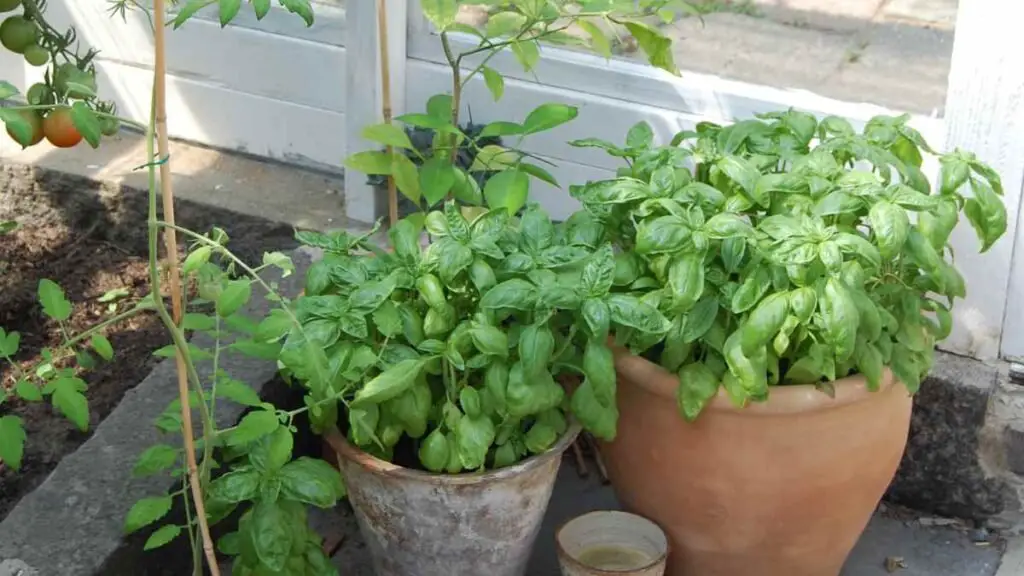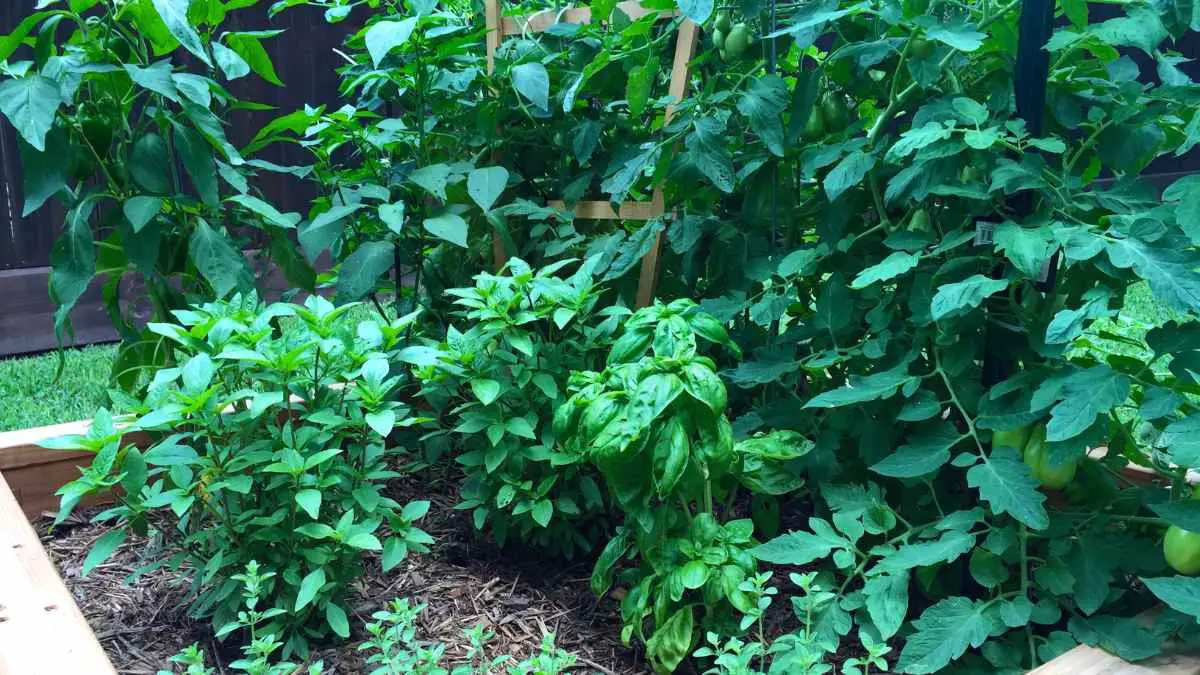Dive into the world of gardening with a striking contrast between basil and tomato plants. While basil thrives in warm, sunny spots, tomato plants, a fruit crop, require ample sunlight but can withstand cooler temperatures. Discover the aromatic wonders of basil leaves alongside the juicy sweetness of homegrown tomatoes. With their distinct care needs, taste, leaves, and flavors, these plants offer a diverse and rewarding experience for any gardener.
Key Takeaways
- Companion Planting Benefits: Planting basil and tomato together can enhance the growth and taste due to their mutual benefits.
- Actionable Insight: Consider planting basil alongside tomato plants to improve pest resistance and overall health.
- Protective Shelter Role: Basil acts as a natural pest repellent for tomatoes, creating a protective environment for both plants.
- Maximize Garden Yield: Utilize companion planting techniques like basil and tomato pairings to increase the productivity of your garden.
- Enhanced Pest Control: By understanding the mechanisms of companion planting, you can effectively suppress pests and reduce the need for chemical interventions.
- Harmonious Planting: Following the recommended pairings and planting guide can lead to a harmonious garden ecosystem that benefits all plants involved.
Companion Planting Overview

Basics Explained
Companion planting involves planting different crops together to benefit each other. This practice enhances soil quality and plant health. The relationship between basil and tomato plants in companion planting is symbiotic.
Historically, companion planting dates back to ancient civilizations. These practices were essential for maximizing crop yields and pest control. The Three Sisters agricultural technique, which includes corn, beans, and squash as companion plants, is a prime example of this strategy.
Historical Background
Ancient civilizations like the Native Americans and the Mayans utilized companion planting techniques. They understood the benefits of planting certain crops together. The Three Sisters method exemplifies how different plants can support each other's growth.
Companion planting offers various benefits such as natural pest control and weed suppression. By intermingling compatible plants, gardeners can reduce the need for chemical pesticides. This method also attracts beneficial insects that prey on harmful pests.
Benefits Highlighted
One key advantage of companion planting is its ability to reduce insect damage to crops naturally. By strategically pairing plants that complement each other, gardeners can create a balanced ecosystem in their gardens. This method also helps in suppressing weeds without the use of harmful chemicals.
Historical Significance
Traditional Practices
Companion planting, a traditional agricultural practice, involves planting different crops together to enhance growth and deter pests naturally. This method has been utilized for centuries by various cultures worldwide. For example, Native American tribes planted corn, beans, and squash together in a technique known as the "Three Sisters."
The cultural significance of companion planting practices is profound. Many ancient societies believed that certain plant combinations could promote better harvests and protect against negative energies. For instance, Chinese farmers paired aromatic herbs with vegetables to repel insects without using harmful chemicals.
Exploring how traditional practices have influenced modern gardening techniques reveals a blend of old wisdom and new knowledge. Gardeners today continue to implement companion planting strategies based on historical methods while incorporating scientific research findings. This integration results in sustainable gardening practices that benefit both plants and the environment.
20th Century Trends
The evolution of companion planting in the 20th century saw a shift towards more systematic approaches backed by scientific research. Researchers began to study plant interactions and their impact on growth and pest control. This led to the development of companion planting guides based on empirical evidence rather than folklore.
Modern innovations in companion planting include the use of trap crops, intercropping, and polycultures to maximize garden productivity. These methods aim to create balanced ecosystems within gardens, reducing the need for synthetic pesticides and fertilizers. Moreover, advancements in technology have enabled gardeners to access information on plant compatibility easily.
Scientific advancements have significantly impacted companion planting practices by providing insights into plant chemistry and ecological relationships. Studies have shown that certain plants emit compounds that repel pests or attract beneficial insects, leading to more effective pest management strategies. As a result, gardeners can make informed decisions when selecting plant combinations for their gardens.
Understanding Mechanisms
Nutrient Provision
Companion planting enhances nutrient provision by creating a diverse ecosystem where plants support each other. Certain plants, like legumes, play a crucial role in fixing nitrogen, enriching the soil for neighboring plants. For instance, planting basil alongside tomato plants can improve soil fertility by providing essential nutrients.
Trap Cropping
Trap cropping involves planting specific crops to attract pests away from main crops, acting as a natural pest management strategy. By utilizing trap cropping, farmers can effectively divert pests from damaging valuable crops. An example of this is planting marigolds around tomato plants to lure pests like aphids away.
Weed Suppression
Weed suppression in companion planting refers to using certain plant combinations to inhibit weed growth naturally. Plants like basil and tomatoes can help control weeds through their growth patterns and root systems. By interplanting these species strategically, gardeners can reduce the need for synthetic herbicides.
Pest Suppression Techniques
Host-Finding Disruption
Host-finding disruption plays a crucial role in pest control by confusing pests and preventing them from locating plants. Companion planting involves strategically placing plants that emit strong scents to mask the odor of crops, making it challenging for pests to find their host. Aromatic companions like marigolds and lavender release volatile compounds that interfere with pests' ability to detect their desired plants.
Companion planting not only enhances the aesthetic appeal of gardens but also serves as a natural pest control method. By disrupting the host-finding process, gardeners can effectively reduce pest infestations without relying on harmful chemicals. The strategy of using aromatic companions is an environmentally friendly approach that promotes biodiversity and supports overall plant health.
Predator Recruitment
Predator recruitment is a key concept in companion planting, where certain plants attract beneficial predators that feed on pests. By incorporating specific plants into gardens, such as dill and fennel, gardeners can encourage predatory insects like ladybugs and lacewings to thrive in the area. These predators play a vital role in maintaining ecological balance by preying on common garden pests like aphids and caterpillars.
Companion plants that aid in predator recruitment contribute to the overall resilience of garden ecosystems. The presence of beneficial predators helps naturally regulate pest populations, reducing the need for chemical interventions. Through strategic planting choices, gardeners can create a harmonious environment where natural enemies of pests are attracted and supported.
Mutual Benefits Explained
Basil for Tomatoes
Growing basil near tomato plants offers numerous benefits. Basil acts as a natural pest repellent, protecting tomatoes from harmful insects. The strong aroma of basil helps deter pests like aphids and spider mites that commonly attack tomato plants. This symbiotic relationship between basil and tomatoes creates a healthier environment for both plants.
On top of repelling pests, basil enhances the flavor of tomatoes when grown nearby. The aromatic oils released by basil can improve the taste of tomatoes, making them more flavorful and robust. Basil attracts beneficial insects like bees, which aid in pollination and further support the growth of tomato plants.
Tomatoes for Basil
Planting tomatoes alongside basil provides advantages for both plants. Tomato plants emit compounds that help deter pests that commonly target basil, such as mosquitoes and flies. This natural defense mechanism reduces the risk of pest infestations on basil plants when they are grown near tomatoes.
Moreover, the proximity of tomatoes to basil can enhance the growth of basil plants. Tomatoes release certain chemicals into the soil that benefit neighboring plants like basil by improving their overall health and vitality. This positive interaction between tomato and basil plants results in mutually beneficial outcomes for both crops.
Planting Guide
Companion Pairing
Companion planting involves selecting compatible companion plants to enhance growth and deter pests naturally. Certain plant combinations, like basil and tomatoes, can benefit each other by repelling harmful insects or attracting beneficial ones. Pairing plants based on their beneficial interactions creates a harmonious environment in the garden.
Effective companion planting strategies include interplanting basil with tomatoes to deter pests like aphids and hornworms. When planning a companion planting layout, consider the growth habits of each plant to ensure they complement each other. Maximizing the benefits of companion planting involves rotating crops annually and avoiding planting the same family of plants in the same spot consecutively.
Effective Approaches
To achieve successful companion planting, gardeners should focus on diversity within the garden to attract a wide range of beneficial insects. Key considerations include choosing plants that have mutually beneficial relationships, such as marigolds deterring nematodes from attacking tomato roots. Incorporating herbs like basil around tomato plants can improve flavor and repel pests naturally.
Tips for maximizing the benefits of companion planting include creating complementary pairings such as planting chives near tomatoes to deter aphids. Using tall plants like sunflowers as a windbreak for delicate crops can protect them from strong winds. By incorporating a variety of plants with different growth habits, gardeners can create a balanced ecosystem that promotes overall plant health.
Protective Shelter Role
Plant Growth Support
Companion planting plays a crucial role in supporting plant growth by providing various benefits. When basil and tomato plants are planted together, basil acts as a natural pest repellent for tomatoes, protecting them from harmful insects. This symbiotic relationship helps in maintaining the overall health of both plants.
The combination of basil and tomato plants can significantly improve crop productivity. Basil emits compounds that deter pests like aphids, mosquitoes, and flies, thereby reducing the chances of damage to the tomato plants. This leads to healthier tomato crops with higher yields due to fewer pest-related issues.
Specific plant combinations, such as basil and tomato plants, can enhance plant health and yield through mutual support. Basil releases essential oils that not only repel pests but also attract beneficial insects like bees and butterflies, aiding in pollination. This results in increased fruit production and improved quality of tomatoes.
Advanced Strategies
Weed Management
Companion planting plays a crucial role in natural weed management by utilizing the symbiotic relationships between different plants. By strategically pairing basil and tomato plants, gardeners can effectively suppress weed growth naturally. For instance, planting basil alongside tomatoes creates a natural barrier that inhibits weed germination and growth. This sustainable approach not only reduces the need for chemical herbicides but also enhances the overall health of the garden ecosystem.
Incorporating marigolds with basil and tomatoes is another effective strategy for weed management. Marigolds release compounds that deter pests while suppressing weeds, creating a harmonious environment for basil and tomato growth. This practice not only minimizes manual weeding efforts but also promotes biodiversity in the garden, contributing to long-term soil health.
Natural Pest Control
Companion planting contributes significantly to natural pest control by harnessing the power of plant interactions. Basil emits a strong aroma that repels pests like aphids, mosquitoes, and flies, protecting nearby tomato plants from infestations. Planting garlic near basil and tomatoes can further enhance pest control efforts due to garlic's natural insect-repelling properties.
Certain plants attract beneficial insects that act as natural enemies to common pests. For example, planting dill near basil and tomatoes attracts predatory insects like ladybugs and lacewings, which feed on harmful pests such as aphids and caterpillars. This integrated pest management approach not only reduces reliance on chemical pesticides but also fosters a balanced ecosystem within the garden.
Recommended Pairings
Tomatoes with Basil
When planting tomatoes with basil, it's essential to consider their compatibility. These two plants complement each other well in the garden, both in terms of growth and pest control. Basil acts as a natural repellent for pests that commonly affect tomato plants, such as aphids and hornworms. However, ensure they have enough space between them to thrive individually.
Growing tomatoes alongside basil offers numerous benefits. The aromatic presence of basil can enhance the flavor of tomatoes, making them more delicious. This pairing can attract beneficial insects like bees and butterflies to the garden, promoting pollination and overall plant health.
On the flip side, there are some drawbacks to consider when planting tomatoes with basil. Due to their different watering needs, it's crucial to monitor soil moisture levels carefully. Overwatering one while underwatering the other can lead to issues like root rot or nutrient deficiencies.
To optimize the companion planting relationship between tomatoes and basil, follow these tips:
- Plant them in a sunny location with well-draining soil.
- Ensure proper spacing to prevent overcrowding and allow for good air circulation.
- Prune regularly to maintain plant health and avoid overcrowding.
- Water consistently but adjust based on individual plant requirements.
Final Remarks
In companion planting, basil and tomato plants exhibit a harmonious relationship that enhances growth and deters pests naturally. Understanding the mechanisms behind this synergy allows you to implement effective pest suppression techniques and maximize mutual benefits in your garden. By following the planting guide, providing protective shelter, and considering advanced strategies and recommended pairings, you can create a thriving ecosystem for your plants.
As you embark on your gardening journey, remember the power of companion planting with basil and tomatoes. Take action by implementing these strategies in your garden to promote healthy growth and natural pest control. Your efforts will not only yield bountiful harvests but also contribute to a sustainable and environmentally friendly approach to gardening.
Frequently Asked Questions
What is companion planting and why is it important for basil and tomato plants?
Companion planting involves planting different crops near each other to benefit one another. Basil and tomato plants are excellent companions as they enhance each other's growth, flavor, and help repel pests naturally.
How can historical significance influence the planting of basil and tomato together?
Historically, basil and tomato have been cultivated together due to their mutual benefits. Their compatibility in growth patterns, pest resistance, and flavor enhancement has been recognized over centuries, making them popular companions.
What are the mechanisms behind the mutual benefits of basil and tomato plants when planted together?
When basil and tomato plants are grown together, they release chemical compounds that deter pests harmful to each other. Basil enhances the flavor of tomatoes while also improving their growth by providing natural nutrients to the soil.
What are some advanced strategies for maximizing the benefits of planting basil and tomato together?
To optimize the benefits of companion planting with basil and tomato plants, consider intercropping with other compatible herbs or vegetables. Implement crop rotation techniques to maintain soil health, prevent disease buildup, and ensure continuous harvests throughout the seasons.
Can you provide a recommended pairing guide for planting basil and tomatoes with other compatible plants?
For an effective companion planting strategy with basil and tomatoes, consider pairing them with marigolds for pest control, peppers for increased yields, or beans for nitrogen fixation. These pairings create a harmonious ecosystem that promotes healthy growth and abundant harvests.
Image Source: Paid image from CANVA




